|
|
| About Venice Biennale | |
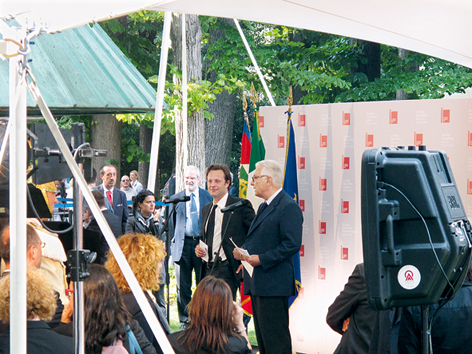 Opening of the 53rd International Art Exhibition of the Venice Biennale. At the centre from the left: curator of the exhibition Daniel Birnbaum and the president of the Venice Biennale Paolo Baratta. Publicity photo | |
| What is a "must-see" at the 53rd International Art Exhibition of the Venice Biennale, and why? Inese Baranovska: Among the national pavilions it is the USA, Russia, Scandinavia, Denmark, the Netherlands, Spain, Hungary; outside of the Giardini - Mexico, New Zealand (Francis Upritchard, Save Yourself), Iceland, and, of course, Latvia, Estonia, Lithuania. At the Arsenale, take a boat to the newly acquired spaces and visit two exhibitions: Unconditional Love and Jan Fabre's impressive From the Cellar to the Attic - From the Feet to the Brain. Irēna Bužinska: Everybody has their own itinerary in this event. Taking into account that 77 countries are represented and that at least 44 other exhibitions complement its program, then even for a keen art admirer with a schedule that has been carefully planned out beforehand it is extremely difficult to see everything. Given the above, I thought that the principle of chance as proposed by the Latvian artist Voldemārs Matvejs was attractive. I followed this principle with genuine pleasure, being confident that within a four day timeframe, I would manage to see among the huge range on offer exactly those things which were the most necessary to me in spiritual, emotional and purely professional terms. In addition, I regarded the Biennale visit as kind of "happening", where my own attitude, development, activities, conclusions and unexpected impressions acquired en route are of importance, and not just the destination - the next exhibition. I was attracted to the Italian exhibition Collaudi, developed by the curators Luca Beatrice and Beatrice Buscaroli, which is at the same time a dedication to the 100th anniversary of Futurism, comprising a sizeable share of the creative continuation of Futurism in painting. However, the most convincing were the installations where various materials were used, such as Nicole Bolla's Dream of Orpheus (a unicorn made of metal, covered with crystals and surrounded by microphones), Rebus by Bertozzi & Casoni - a painted naturalistic spruce made of bronze in combination with polychromatic ceramic balls with Eastern erotic scenes painted on them, along with the same artists' installation titled Composizione non finita - infinita: a wall covered with almost a hundred first aid kit boxes made of bronze, each of them housing another surreal, funky composition of painted ceramic articles. These works surprise with the unexpected use of materials, "technological decadence" that repeatedly urges us to alter perceptions about the inexhaustible creative possibilities in the use of completely different materials and their combinations. An equally great surprise was the cafeteria Palazzo della Esposizioni, created by the German artist Tobias Rehberger. This artist, who works in various fields of art, fascinates with a fantastic (and characteristic to him) fusion of art, design and architecture elements, and in this work he has managed to transform the traditional public environment, meanwhile maintaining its functionality and at the same time assigning to it the status of a unique art work. I was charmed by the subtle poetics of the Slovak and Czech pavilion at Giardini, housing Roman Ondák's installation Loop. The installation is a successful transference of the ambient environment to interior space, whereby a gravel path is made underneath the pavilion roof, along with the planted bushes and trees that are also present behind the pavilion building. The effect is enhanced by the missing doors - there are only doorframes that give an opportunity to walk around it. Initially one doesn't even understand that everything seen here is an art work - and, for me at least, the blend of natural and artificial environment, created by the human, was intriguing. Similar principles underlie Lara Favaretto's Swamp, located in the green area behind the Arsenale building. Such extraordinary human intervention in a beautiful garden is like a sudden flash of memories, suppressed unwelcome emotions or evanscent thoughts, which can be raked up by such an unconventional green corner in the urban environment. Do not miss an opportunity to visit the different national exhibitions, situated in various areas of Venice, as these provide a chance to get to know the narrow streets of Venice and the buildings that would otherwise be impossible to access, for instance, the Palazzo Michiel dal Brusà, built in the 14th century and located by the Grand Canal, not far from the Rialto Bridge. The Singapore and Iceland national participations are housed here, on several floors. The exhibition Life of Imitation by the Singaporean artist Ming Wong consists of cinema and video projections - shuffled scenes from genuine films and staged scenes from non-existent, fictional films, and also billboards and photographs devoted to Singapore's cinema in the 1950s and 60s, as well as to the canons of the depiction the human image in Eastern culture. Meanwhile the Icelandic artist Ragnar Kjartansson gives the opportunity to experience the atmosphere generated by an artist's creative work. The premises on the ground floor of the Palazzo have been transformed into a studio and the audience can witness the painting of a portrait of a model, to the accompaniment of classical music. | |
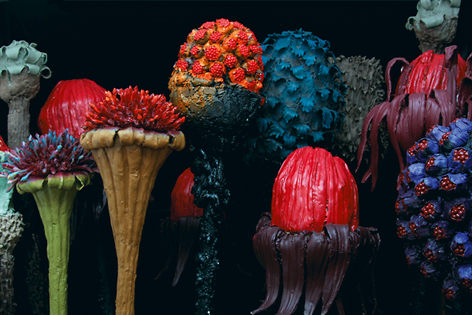 Nathalie Djuberg. Experimentet. By courtesy Gio Marconi, Milan. Zach Feuer Gallery, New York | |
| Jana Kukaine: If the queue at the entrance of some pavilions (for instance those of the Netherlands, France, Great Britain and the Nordic countries) is not considered the criterion for a "must see", then I cannot determine a indisputable "box office hit". Kristīne Kursiša: I don't think that the phrase "must see" is applicable to this year's exhibition. There were a few really excellent works, which were selected autonomously by the national pavilions, but I would rather see these artists in more suitable premises or even in a different context. I liked Apology to Roadkill (2007-2009) and Interceptor Surf: Daydream Mine Road (2009) by the Australian Shaun Gladwell, The End by Ragnar Kjartansson from Iceland, Miks Mitrēvics' Sun Filled Room and Hair Dryer, and also Chu Yun's Constellation. The Irish pavilion astonished not so much for its artworks, as for the extraordinary quality of the exposition, the attention to detail and the finish. Daiga Rudzāte: The Latvian exhibit is a must-see, because at a time when Latvian self-confidence could be at a serious low, this is a place to draw "positive emotions". The Latvian exhibit is convincing in all aspects - artistic, emotional, intellectual and craftsmanship, and illustrates director Birnbaum's chosen theme more convincingly and on a greater number of levels than his own exhibit. Then I would recommend continuing with the Giardini exhibitions - the Russian, French, Danish and Nordic, and Spanish pavilions. The pavilions of Great Britain and the USA - if you're looking for chrestomathic phenomena. Nathalie Djurberg's work at the Palazzo delle Esposizioni. The collateral events of the Biennale, like Jan Fabre's exhibition at the Arsenale Novissimo, Mapping the Studio at Punta della Dogana and Palazzo Grassi etc. Norbert Weber: Let me begin by mentioning pavilions that can be skipped without losing substance, and saving time. At the Giardini, this applies to the Egyptian pavilion, (which is always closer to craft than art). The tendency to show craft rather than art also applies to Morocco. The Brazilian pavilion provides standard kinds of productions (as has often been the case in the past). I find this to be peculiar, as I think of all the talent existing in this Latin American country. Greece, New Zealand, Monaco and Spain present a sufficiently known standard for modern art. The Armenian pavilion is disappointing, not in terms of the art, but in the choice of the artist Gayané Khachaturian, who has merit as a representative of Armenian art brut. It results in a missed opportunity by the commissioners to inform the international audience of more challenging and contemporary works. A highlight for me was the Dutch pavilion, i.e. the work of Fiona Tan. I particularly liked her double screen projection Rise and Fall, a work about the conflicting nature of a woman's experience of time passing. Another interesting exhibit was Krzysztof Wodiczko's work at the Polish pavilion. I found it to be remarkable in terms of the atmosphere created. The blurred images of people seen through windows were captivating until they became too narrative. Above all, do not miss the Lithuanian pavilion. Though it is a good distance away, there is a great work by Žilvinas Kempinas. The Latvian pavilion, which many colleagues agree is magical thanks to Miks Mitrēvics' and Evelīna Deičmane's precise and pulsating works, is also not to be missed. While some of the other nations' contributions (e.g. Germany, Greece, Austria) do not manage to fill their large spaces with energy, the small Latvian space is by far, so energetic, it seems to result in a kind of implosion. Armands Zelčs: The Latvian exhibition, Fragile Nature! Missing it could have made it rather difficult to justify the purpose of my visit. It wouldn't hurt to see the pavilions of Iceland, Australia and Germany as well, but my particular recommendation is the joint Danish and Nordic exposition, The Collectors. | |
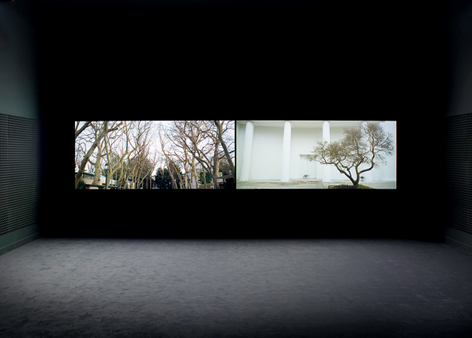 Steve McQueen. Giardini | |
| What importance did Daniel Birnbaum's concept ‘Making Worlds' have for your perception of the Biennale? Did the exhibition reveal the curator's idea? Inese Baranovska: At the Arsenale the curator's idea was reflected less clearly than at previous exhibitions, but what sticks in my mind is the central pavilion at the Giardini. Orientation to the concept set by the curator was to a greater or lesser extent evident at the national pavilion exhibitions, at times even more pronouncedly than at the Arsenale. I am very happy and proud of the Latvian exhibition this time: Evelīna Deičmane and Miks Mitrēvics had each created their own world - fragile, sensitive and true. Irēna Bužinska: For me at least, Daniel Birnbaum's concept of "Making Worlds" carried crucial significance. I think that, not only his own exhibition, but also the exhibitions of many other countries and works by particular artists convincingly tackled the idea of making worlds. One group of authors had put the curator's concept into practice in the form of architectural space, where relations between human and urban environments were being explored (for instance, Carsten Höller). Others chose to get to know the world as a primal or rather more civilised garden. Here we can mention the British artist Steve McQueen, whose video gave the opportunity to get acquainted with the Giardini when there are no exhibitions taking place, or the above-mentioned Czech and Slovak pavilion. For some other artists, the concept allowed them to offer a new virtual world. In this regard, I found Chinese artist Chu Yun's installation Constellation No 3, exhibited in the Arsenale, to be emblematic. The installation consists of non-functional electric appliances - computers, TV sets, fridges etc. - which do not serve their purpose anymore and are arranged by the author in a darkened room. Now and then, randomly and independently of human intervention, a dim light bulb would light up in one or another of these home appliances doomed to destruction. It is a world made by a human being, yet he has ceased to control that world, where unpredictable developments still occur. The theatre of shadows by the German artist Hans-Peter Feldmann brought up memories of the installation Stīvenam pa pēdām (‘On the Path of Stephen', 2001) created by the Latvian artists Dita and Anta Pence, where the principles of shadow theatre and early cinema were also used. Their joint work would fit in here as well, especially because this exhibition also hosts works that were created a very long time ago, such as Yoko Ono's conceptual texts Instruction Pieces (1960s) and Barres rond (1970-1978) by the French artist André Cadere, which he placed in an urban environment and in the exhibitions of other artists. The presence of these chresthomatic authors and their early works obviously symbolises the continuity of making new worlds of art, thus creating a link between the past and the future, as cultural exchange and the examination of history is indicative not only of our imagination world's evolution, but also of the development of our conceptions about the environment we live in. However, as regards the particular "historic" figures and works selected, the selection criteria were not explicit, and it seemed that the selection was influenced by the principle of fortuity at emotional level. | |
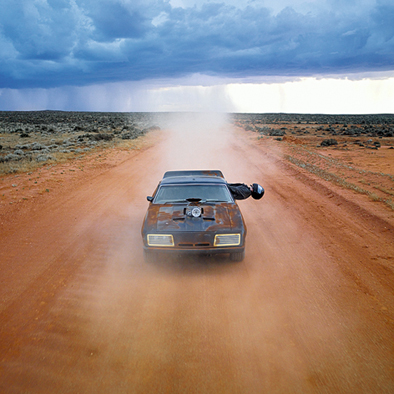 Shaun Gladwell. Interceptour Surf Sequence. Photo: Josh Raymond. Courtesy of the artist, Anna Schwartz Gallery | |
| Jana Kukaine: The curator's concept is haphazard and pretentious, it brings into one's mind a biblical subject and hints at the artist as god almighty, but in the exhibition the idea of "making worlds" - whatever that means - has not been sufficiently elaborated. It seemed that by "the world" the curator understands something like the atmosphere of a work of art, its ability of creating a certain space around itself in which to find a model for survival in the "conflict torn contemporary world", yet this none too original idea can be gleaned from the curator's written comment, not from the works selected. Kristīne Kursiša: By laying stress on succession and displaying a genealogical view of art, Birnbaum demonstrated once again how boring it is to look at a study of a curator's "intellectual," subjective interests imposed on the viewer. It's always strange to hear the global mantra that "the exhibition will help us to better understand where we are right now," considering that the exhibition is a subjective selection of works by the curator and reveals nothing more than where he or she is right now and how broad his or her horizons are. I believe that one should be able to successfully combine the created worlds of self-standing, with their own world view, young and old artists, in addition to selecting them. In my opinion, the very promising concept "making worlds" threw together works that are not stylistically or intellectually compatible. Daiga Rudzāte: Within the context of the Venice Biennale in its entirety, the theme announced by the curator is always secondary. It triumphs, as always, at the Arsenale and the Palazzo delle Esposizioni. Admittedly, the concept, which initially seemed deliberately cleverly constructed to give free rein to thematic and artistic freedom, in the end, in my opinion, turned out to be quite insipidly and narrowly interpreted. Norbert Weber: I think the choice of the theme "making worlds" was not the best or the most relevant to our times. Most artists do not address the concept or embody it in their work. Even at the Arsenale, Daniel Birnbaum's own domain, I did not find artists "making worlds", but making art. In my opinion, Birnbaum's concept fell short, since so many worlds have been explored, yet nothing has changed the human condition. Consider the discoveries of Portuguese sailors, the first step on the moon, achievements in science, be it physics, psychology, medicine, or the progress of modern art in the 20th century. It is all about arriving at new shores, but never reaching paradise. Moreover, new shores are being spoiled instead of being taken care of. What art must be about is not "making worlds", but the stewardship of our world. Armands Zelčs: A concept of this kind of construction is very universal, and there is very little that would not fit in. All that is left is to learn of its existence. | |
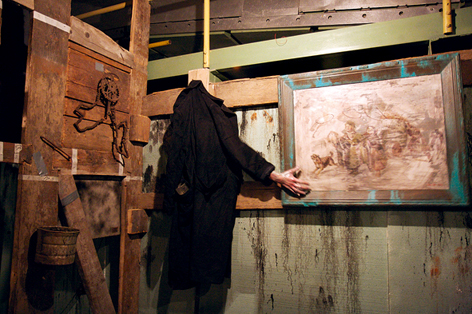 Gosha Ostretsov. Art Life or the Torments of Creation. By courtesy of the Multimedia Art Museum, Moscow | |
| What are your reflections after visiting the Biennale? Inese Baranovska: The Biennale has a tendency to grow in size all the time, particularly if viewed in conjunction with the collateral events, and it is becoming larger and larger and difficult to take in. It is increasingly harder to find the wheat amidst the chaff, but it is definitely worth the effort when you do. In the contemporary art space, the best of the earlier discoveries are reappearing in a new or different format - there is a growing element of play, i.e. interactivity, when the spectator becomes a participant (at the Nordic and Danish pavilions etc.). The boundaries separating different art disciplines are fading. Video, film, theatre, photography, sound, installation, ceramics, design, painting - all of this can be combined, everything can be manipulated. Irēna Bužinska: I got the impression that drawing has flourished, and has regained its diversity and popularity, as it noticeably dominated not only in the main exhibition, but also in other countries' exhibitions. It also seemed that - if I may say so - sensibility is dominating over thought at the moment, and, quite humanly, artists do not hesitate to show this in their works. Thus the title of the Latvian exhibition appropriately defined the quintessence of the current situation: the fragile nature of making worlds. Jana Kukaine: At the Biennale, I attempted to get a feeling of the contemporary way of thinking and the language of art of today. The forms of art recognised in the previous century are currently being replaced by others, and the ideas, as the artists themselves are in the habit of saying, vibrate in the air until they fall into the hands of several authors at once - these are authors who have no connection among themselves. Kristīne Kursiša: I think that if, at present, in the art world - at biennales, in museums, prestigious galleries - priority is not given to innovative, non-commercial artists and young, conceptually strong curators (for example Tim Barber and Adam Budak, who are able to reflect new ideas and trends, nurture the emotional and intellectual growth of the viewer from each work without disturbing the works, while simultaneously setting new priorities and a strong message), either chaos or a period of stagnation will set in. Collectors and museums are the final resting place of works, and they precisely reflect the path trodden by curators and the artists themselves. A work of art should not be so much a component of interior decoration, but it should become an element for developing the imagination and spirit. Daiga Rudzāte: It makes me think of the exhaustion of curatorship as an institution, about the fact that no-one since Harald Szeeman has ever managed to create a monolithic and inspiring exhibition (the exhibition of the curator of the Venice Biennale), which could at the same time be a demonstrative testament to the art process. Norbert Weber: The Venice Biennale is a two-tier system. There are "the haves", i.e. those countries possessing a pavilion at the Giardini, and "the have-nots", forced into remote, expensive and inappropriate spaces. It causes the Biennale to be a highly unfair competition. Therefore, I particularly watched out for spaces to accommodate future Latvian exhibitions. The conditions in this year's small space were very difficult, though both artists managed exceptionally well. Remembering Miks, given the proper space. Let's hope for this in 2011. Armands Zelčs: Too little time, too much information. | |
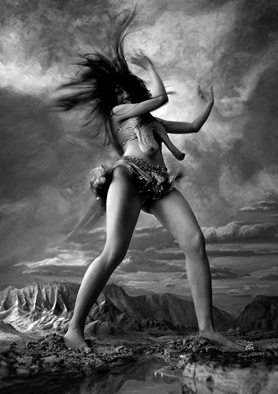 Miwa Yanagi. Windswepty Women - the Old Girls' Troupe. Publicity photo | |
| Which are your favourites at the Biennale, to whom would you award a "Lion"? Inese Baranovska: It just so happens that my favourites are the classics, and several of them took part only in the satellite events of the Biennale: Bruce Nauman, Rebecca Horn and Yoko Ono, for example. The Mexican artist Teresa Margolles was another artist with a very powerful message. Irēna Bužinska: My absolute favourite recipient of a Lion would be the joint Danish and Nordic exhibition The Collectors, created by two artists - Michael Elmgreen and Ingar Dragset. It is a fantastic exhibition of works by many artists (24 authors), combined with elements of performance: the guided tour through a "For Sale" Danish Pavilion, led by a representative of the real estate agency ‘Vigilante' must be mentioned in this regard. Both artists have managed to create a unique ambience, as both parts of the exhibition are rather like pavilions, with decorations of excellent quality and interiors that look as if they were destined for filming or the staging of a theatre play, as opposed to a traditional exhibition. Their accomplishment is original to such extent that it will be impossible to repeat it without being accused of plagiarism. My second favourite Lion recipient would be the artist Pascale Marthine Tayou, born in the Cameroons and now resident in Belgium, for the grand installation Human Being@Work, which is an acknowledgement of how the nomadic way of life and the processes of globalisation quicken up the merging of and interaction between different cultures. I would also award a Lion to the Polish artist Aleksandra Mir, currently residing in Sicily, for her interactive project Venezia (all places contain all others). It consists of one million postcards - 1000 copies of 100 different nature and city views, all of them free for the taking. The common element present on all postcards is water, which is also a feature of Venice itself. Participation of the public bears importance in the successful execution of the project - postcards are meant for posting to or distributing everywhere in the world. I would award the Lion for the successful way in which the artist is promoting contemporary art and her own art. Jana Kukaine: The gold - to the national pavilion of Great Britain for the poetic, nuanced and hazy atmosphere in Steve Mc Queen's film Giardini. I was also moved by other video works, which, instead of the crude aesthetics of amateur cinema, cultivate a filigree visual language. Kristīne Kursiša: Haven't encountered one yet.=) Mentioned in the answer to the first question. =) Daiga Rudzāte: I wouldn't want to award the Lions single-handedly, because debate is an important part of such a process. But I would definitely object to the nomination of the USA pavilion, as Bruce Nauman has already received a Lion for his lifetime achievement, and I see no curatorial role in this, indisputably chrestomathic, retrospective. Norbert Weber: What else could we talk about - is the work which nails the idea perfectly. I would award the Lion to Teresa Margolles and the Mexican pavilion. The artist deals with the horror of killings at the Mexican / U.S. border. The sheets used to wipe the blood from the scene of the drug gang shoot-outs are her media and her message. These sheets are brought to the Mexican pavilion, an old Venetian palazzo. There the cloth is washed out and hung to dry, at the same time the floors are constantly being washed with this bloody water. The work is more a memento mori than a piece of art. Still, it is a work of art, so touching and so poignant a work of art, since it comes from basic human experience. In conversation with the curator Cuauhtémoc Medina I realized just how much he had to fight to make Mexican officials endorse this project. It was worth the fight. Bravo. Armands Zelčs: I don't think I'd interfere with the work of the jury too much, but I wouldn't object if one of the Lions went to the Danish and Nordic pavilion. | |
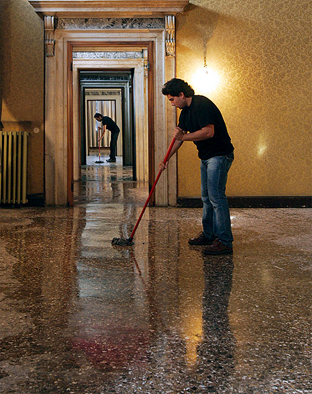 Teresa Margolles. What else could we talk about? | |
| Why did you visit this Biennale? Inese Baranovska: I think it is always worthwhile to attend the Venice Biennale, as it provides a broad overview of the current state of affairs in contemporary art, new trends all over the world; it is a way to keep your "finger on the pulse", so to speak. Irēna Bužinska: The Biennale was not the only reason I visited Venice, I also wanted to see the private collection of the French millionaire François Pinault, located in the Palazzo Grassi and in another place recently established next to the Salute - the Punta della Dogana, the former city customs office building that has been transformed into an art gallery. I think that the concept of "making worlds" has been successfully implemented there also, as proven by Charles Ray's sculpture Boy with Frog, which has immediately become one of the city's trademarks, in addition to being a provocative symbol. Jana Kukaine: Mainly for professional reasons, as well as - curiosity, enthusiasm and patriotism. Kristīne Kursiša: Because I love my husband. Daiga Rudzāte: Because the Venice Biennale provides the greatest chance of seeing the most current trends and innovations of the contemporary art process. For professionals, each Venice Biennale is certainly a definite point of reference. Norbert Weber: The Venice Biennale is a must see for all art professionals and art enthusiasts. All presentations went through serious juries, yet commissioners were free to present the best exhibits. At the Venice Biennale you find a representative collection of the most interesting art of 70 countries. There isn't a better opportunity except for, perhaps, documenta, which is based on a single curator's choice and therefore does not have the broad view that Venice provides. The opening of the Venice Biennale is also a great opportunity to meet with colleagues from all over the world, be it for professional discussions or for relaxed conversations at a party. Here I must mention the marvellous Latvian evening at Nicelli Airport and can recommend Tobias Rehberger's cafeteria at the Giardini for a coffee break to those who will visit Venice only later. Armands Zelčs: So far, for various reasons - valid and less valid - I've already missed 51 Venice Biennales. It was time to change that. /Translator into English: Līva Ozola, Jānis Aniņš, Sarmīte Lietuviete, Filips Birzulis/ | |
| go back | |







